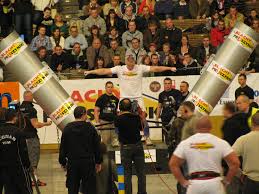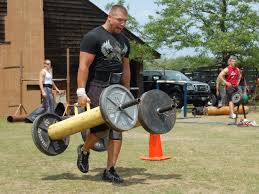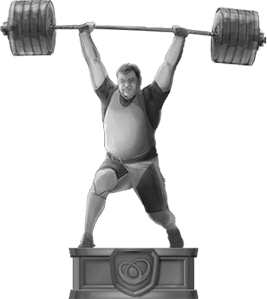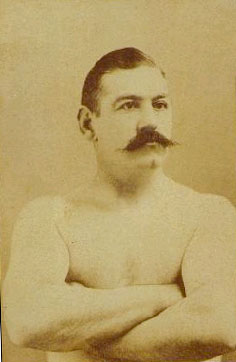Of the three types of grip: crushing, supporting and pinching; supporting grip is the easiest to train in theory and practice. Supporting grip is the ability of the hand to hang on to an implement. It is almost entirely dependent on finger strength. This is a universally important ability whether you’re a mom carrying groceries to the car, or an avid golfer. Many deadlifts have been lost at the last second before the judge gives the down signal, or more importantly firearms dislodged from the users’ hand in a violent confrontation. Again, it is of the utmost importance for a man to have a sturdy supporting grip. How do we develop a better supporting grip?
Simply explained, and in the tradition of being as sport-specific as possible, the grip enthusiast must hold on to the given object for a predetermined length of time. Whether this is until failure or 10 seconds or 5 minutes, the name of the game is to close your hand around the handle of the implement and hang on. This strength is important if your goal is a bigger deadlift, or adding pull-ups. If you’ve ever used straps, you understand how much more poundage you can use in an exercise when your grip is rock solid.
 As an aspiring, young strongman competitor, I was drawn to the simplicity of supporting grip. I had no idea what I was doing in regards to grip, but knew that if I could walk with heavy weights in my hands that I’d have a good supporting grip, and simultaneously I’d improve my farmers’ walk. The farmers’ walk, in my opinion, and excluding the squat is the best all-around strength/conditioning exercise that exists. The key to developing a good supporting grip from the farmers’ walk is picking a weight that you can walk with for about 60-90 seconds. In my estimation this is about 60-90 pounds for the average man. Most trainees are going to have to use standard dumbbells at the gym. I’ve never had a problem doing an exercise like this is in a gym setting. Don’t run. Don’t make a spectacle of yourself. Just pickup a pair of dumbbells, and slowly walk around the gym like you’re going to sit down on a bench, and eventually return to the rack and put them away. Make sure that you don’t just walk in a straight line, but instead perform a course with at least one 180 degree turn. While performing the walk, concentrate on crushing the handle and use chalk. If your gym doesn’t allow chalk, buy the liquid chalk and be discreet.
As an aspiring, young strongman competitor, I was drawn to the simplicity of supporting grip. I had no idea what I was doing in regards to grip, but knew that if I could walk with heavy weights in my hands that I’d have a good supporting grip, and simultaneously I’d improve my farmers’ walk. The farmers’ walk, in my opinion, and excluding the squat is the best all-around strength/conditioning exercise that exists. The key to developing a good supporting grip from the farmers’ walk is picking a weight that you can walk with for about 60-90 seconds. In my estimation this is about 60-90 pounds for the average man. Most trainees are going to have to use standard dumbbells at the gym. I’ve never had a problem doing an exercise like this is in a gym setting. Don’t run. Don’t make a spectacle of yourself. Just pickup a pair of dumbbells, and slowly walk around the gym like you’re going to sit down on a bench, and eventually return to the rack and put them away. Make sure that you don’t just walk in a straight line, but instead perform a course with at least one 180 degree turn. While performing the walk, concentrate on crushing the handle and use chalk. If your gym doesn’t allow chalk, buy the liquid chalk and be discreet.
I trained the farmers’ walk four to five times a week, and performed three sets of the aforementioned exercise per session. Eventually, through this method I was able to develop one of the better grips in professional strongman, and I never lost a deadlift in training or competition. To supplement the farmers’ walk I also did static holds with heavier weights on a standard Olympic bar using a double pronated grip. This activity focused on adapting heavier weights for shorter periods of time. The challenge with this exercise is fighting the motion of the bar which has a tendency to roll forward. The setup for this technique is setting up in a standard squat cage, and utilizing the safety pins. The bar starts on the pins (similar to setting up for shrugs), take the bar off the pins, and hold. Again focusing on crushing the bar is the strategy. The weight range for this is about 30-40 percent higher than the farmers’ walk. This exercise can be done 1-2 times per week for 3 sets until failure. This exercise is an adaptive strategy, and can be taxing to the nervous system. Don’t overdo it.
Years ago, I was competing in a small regional competition and it was the promoter’s first crack at running a show. He had decided that one of the events would have the competitors hanging from a bar for as long as they could. Bodyweight exercises don’t make for good events for the audience, but more importantly they don’t determine maximal strength, but instead strength to bodyweight ratio. There was two divisions, under and over 190 pounds. The promoter had a piece of equipment built that looked like playground equipment. It was an A-frame with a 1” bar about 8 feet off the ground between the two stabilizing posts. We were expected to hang from this 1” bar for as long as we could. Although the results didn’t conclusively prove which competitor had the best supporting grip, it did give me another idea for future training tactics. I began to hang a 150 pound dumbbell from my waist, and took a pull up position, and timed my holds. Once I was able to surpass the one minute mark, I would add weight to the support belt. A side note, the 165 bodybuilder competing in the under 190 pound division was settling in nicely with a 2 minute plus hang looking like he was good for well over 5 minutes , when my friend and current strength and conditioning for a professional sports team yelled out during a lull in noise from the crowd, “grow a cock”. The crowd erupted in laughter and promptly ended the bodybuilders’ concentration and he fell.
 This brings me to an important point, pain. Supporting holds take a tremendous amount of concentration and pain tolerance. If your set up is correct, the skin in the palm of the hand should feel like it’s going to tear. This is a very, very rare occurrence, if the hand is properly conditioned. In competition my focus was always on the pain that Christ endured on the cross. It’s vital that you concentrate on something that distracts from the pain, and aids you in hanging on a little longer. Raucous music helps with the distraction. Make sure that either you time every set, or better yet have someone else time your sets.
This brings me to an important point, pain. Supporting holds take a tremendous amount of concentration and pain tolerance. If your set up is correct, the skin in the palm of the hand should feel like it’s going to tear. This is a very, very rare occurrence, if the hand is properly conditioned. In competition my focus was always on the pain that Christ endured on the cross. It’s vital that you concentrate on something that distracts from the pain, and aids you in hanging on a little longer. Raucous music helps with the distraction. Make sure that either you time every set, or better yet have someone else time your sets.
A lot of grip experts, like Jedd Johnson advocate using bars of various thicknesses, and using gloves while doing static holds. I personally don’t have experience with much thick bar training, or using gloves, but I’ve heard it can yield positive results. I believe that if you follow my basic premise of static holds, farmers’ walks, and bar hangs along with deadlifts and pullups that you’ll develop a tremendous supporting grip and never lose another deadlift again.









5
4.5